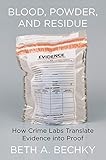Blood, Powder, and Residue : How Crime Labs Translate Evidence into Proof / Beth A. Bechky.
Material type: TextPublisher: Princeton, NJ : Princeton University Press, [2021]Copyright date: ©2021Description: 1 online resource (248 p.) : 10 b/w illusContent type:
TextPublisher: Princeton, NJ : Princeton University Press, [2021]Copyright date: ©2021Description: 1 online resource (248 p.) : 10 b/w illusContent type: - 9780691205854
- Crime laboratories
- Crime scene searches
- Criminal investigation
- Forensic sciences
- Forensic scientists
- SOCIAL SCIENCE / Criminology
- CSI Cyber
- CSI Las Vegas
- CSI Miami
- CSI New York
- CSI
- DNA profiling
- crime scene investigation
- criminalist
- ethnography
- expert work
- expertise
- knowledge work
- occupations
- organizational theory
- organizations
- 363.25 23
- HV8073 .B43 2021eb
- online - DeGruyter
| Item type | Current library | Call number | URL | Status | Notes | Barcode | |
|---|---|---|---|---|---|---|---|
 eBook
eBook
|
Biblioteca "Angelicum" Pont. Univ. S.Tommaso d'Aquino Nuvola online | online - DeGruyter (Browse shelf(Opens below)) | Online access | Not for loan (Accesso limitato) | Accesso per gli utenti autorizzati / Access for authorized users | (dgr)9780691205854 |
Frontmatter -- CONTENTS -- Preface -- Introduction: Welcome to the Crime Lab -- PART 1: THE WORK OF CRIMINALISTS -- Chapter 1. Forensic Scientists at the Lab Bench -- Chapter 2. The Social Worlds of Forensic Science -- PART 2: THE CULTURE OF CRIMINALISTS -- Chapter 3. A Culture of Anticipation -- Chapter 4. Creating a Culture of Anticipation in the Crime Laboratory -- PART 3: THE STRUGGLES OF CRIMINALISTS -- Chapter 5. The Specter of Testifying -- Chapter 6. DNA Envy -- Conclusion -- Appendix: Case Notes on an Ethnography of a Crime Laboratory -- Acknowledgments -- Notes -- References -- Index
restricted access online access with authorization star
http://purl.org/coar/access_right/c_16ec
A rare behind-the-scenes look at the work of forensic scientistsThe findings of forensic science—from DNA profiles and chemical identifications of illegal drugs to comparisons of bullets, fingerprints, and shoeprints—are widely used in police investigations and courtroom proceedings. While we recognize the significance of this evidence for criminal justice, the actual work of forensic scientists is rarely examined and largely misunderstood. Blood, Powder, and Residue goes inside a metropolitan crime laboratory to shed light on the complex social forces that underlie the analysis of forensic evidence.Drawing on eighteen months of rigorous fieldwork in a crime lab of a major metro area, Beth Bechky tells the stories of the forensic scientists who struggle to deliver unbiased science while under intense pressure from adversarial lawyers, escalating standards of evidence, and critical public scrutiny. Bechky brings to life the daily challenges these scientists face, from the painstaking screening and testing of evidence to making communal decisions about writing up the lab report, all while worrying about attorneys asking them uninformed questions in court. She shows how the work of forensic scientists is fraught with the tensions of serving justice—constantly having to anticipate the expectations of the world of law and the assumptions of the public—while also staying true to their scientific ideals.Blood, Powder, and Residue offers a vivid and sometimes harrowing picture of the lives of highly trained experts tasked with translating their knowledge for others who depend on it to deliver justice.
Mode of access: Internet via World Wide Web.
In English.
Description based on online resource; title from PDF title page (publisher's Web site, viewed 01. Dez 2022)


